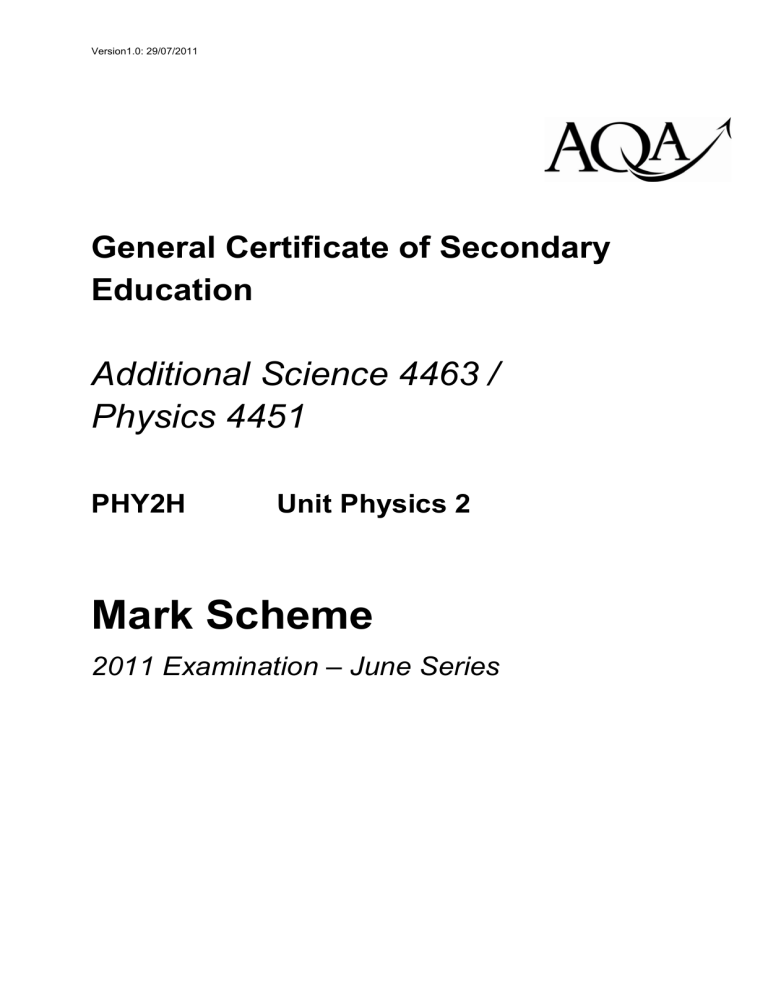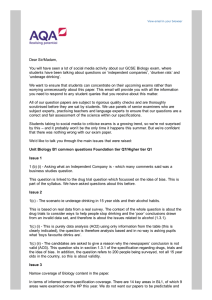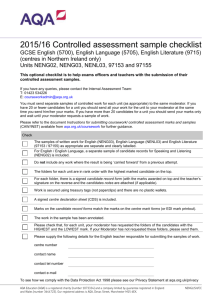
Version1.0: 29/07/2011
General Certificate of Secondary
Education
Additional Science 4463 /
Physics 4451
PHY2H
Unit Physics 2
Mark Scheme
2011 Examination – June Series
Mark schemes are prepared by the Principal Examiner and considered, together with the
relevant questions, by a panel of subject teachers. This mark scheme includes any
amendments made at the standardisation meeting attended by all examiners and is the scheme
which was used by them in this examination. The standardisation meeting ensures that the
mark scheme covers the candidates’ responses to questions and that every examiner
understands and applies it in the same correct way. As preparation for the standardisation
meeting each examiner analyses a number of candidates’ scripts: alternative answers not
already covered by the mark scheme are discussed at the meeting and legislated for. If, after
this meeting, examiners encounter unusual answers which have not been discussed at the
meeting they are required to refer these to the Principal Examiner.
It must be stressed that a mark scheme is a working document, in many cases further
developed and expanded on the basis of candidates’ reactions to a particular paper.
Assumptions about future mark schemes on the basis of one year’s document should be
avoided; whilst the guiding principles of assessment remain constant, details will change,
depending on the content of a particular examination paper.
Further copies of this Mark Scheme are available to download from the AQA Website: www.aqa.org.uk
Copyright © 2011 AQA and its licensors. All rights reserved.
COPYRIGHT
AQA retains the copyright on all its publications. However, registered centres for AQA are permitted to copy material
from this booklet for their own internal use, with the following important exception: AQA cannot give permission to
centres to photocopy any material that is acknowledged to a third party even for internal use within the centre.
Set and published by the Assessment and Qualifications Alliance.
The Assessment and Qualifications Alliance (AQA) is a company limited by guarantee registered in England and Wales (company number 3644723) and a registered charity (registered charity number 1073334).
Registered address: AQA, Devas Street, Manchester M15 6EX
2
Additional Science / Physics – PHY2H – AQA GCSE Mark Scheme 2011 June Series
Marking Guidance for Examiners
GCSE Science Papers
1.
General
The mark scheme for each question shows:
•
the marks available for each part of the question
•
the total marks available for the question
•
the typical answer or answers which are expected
•
extra information to help the Examiner make his or her judgement and help to
delineate what is acceptable or not worthy of credit or, in discursive answers,
to give an overview of the area in which a mark or marks may be awarded.
The extra information is aligned to the appropriate answer in the left-hand part of
the mark scheme and should only be applied to that item in the mark scheme.
At the beginning of a part of a question a reminder may be given, for example:
where consequential marking needs to be considered in a calculation;
or the answer may be on the diagram or at a different place on the script.
In general the right hand side of the mark scheme is there to provide those extra
details which confuse the main part of the mark scheme yet may be helpful in
ensuring that marking is straightforward and consistent.
2.
3.
Emboldening
2.1
In a list of acceptable answers where more than one mark is available ‘any
two from’ is used, with the number of marks emboldened. Each of the
following lines is a potential mark.
2.2
A bold and is used to indicate that both parts of the answer are required to
award the mark.
2.3
Alternative answers acceptable for a mark are indicated by the use of or.
(Different terms in the mark scheme are shown by a / ; eg allow smooth /
free movement.)
Marking points
3.1
Marking of lists
This applies to questions requiring a set number of responses, but for
which candidates have provided extra responses. The general principle to
be followed in such a situation is that ‘right + wrong = wrong’.
Each error/contradiction negates each correct response. So, if the number
of error/contradictions equals or exceeds the number of marks available for
the question, no marks can be awarded.
However, responses considered to be neutral (indicated as * in example 1)
are not penalised.
3
Additional Science / Physics – PHY2H – AQA GCSE Mark Scheme 2011 June Series
Example 1: What is the pH of an acidic solution? (1 mark)
Candidate
Response
Marks
awarded
1
4,8
0
2
green, 5
0
3
red*, 5
1
4
red*, 8
0
Example 2: Name two planets in the solar system. (2 marks)
3.2
Candidate
Response
Marks awarded
1
Pluto, Mars, Moon
1
2
Pluto, Sun, Mars,
Moon
0
Use of chemical symbols / formulae
If a candidate writes a chemical symbol / formula instead of a required
chemical name, full credit can be given if the symbol / formula is correct
and if, in the context of the question, such action is appropriate.
3.3
Marking procedure for calculations
Full marks can be given for a correct numerical answer, as shown in the
column ‘answers’, without any working shown.
However if the answer is incorrect, mark(s) can be gained by correct
substitution / working and this is shown in the ‘extra information’ column;
3.4
Interpretation of ‘it’
Answers using the word ‘it’ should be given credit only if it is clear that the
‘it’ refers to the correct subject.
3.5
Errors carried forward
Any error in the answers to a structured question should be penalised once
only.
Papers should be constructed in such a way that the number of times
errors can be carried forward are kept to a minimum. Allowances for errors
carried forward are most likely to be restricted to calculation questions and
should be shown by the abbreviation e.c.f. in the marking scheme.
3.6
Phonetic spelling
The phonetic spelling of correct scientific terminology should be credited
unless there is a possible confusion with another technical term.
3.7
Brackets
(…..) are used to indicate information which is not essential for the mark to
be awarded but is included to help the examiner identify the sense of the
answer required.
4
Additional Science / Physics – PHY2H – AQA GCSE Mark Scheme 2011 June Series
PHY2H
Question 1
question
answers
1(a)
brown
1(b)
outside/case is plastic / an
insulator
extra information
mark
1
accept is double insulated
1
accept non-conductor for plastic
do not accept it / hairdryer is
plastic
1(c)(i)
1(c)(ii)
1(d)
(1) S1
and no other
1
(2) S1 and S3
both required, either order
1
S1 must be ON (for either heater to
work)
do not accept reference to ‘fan’
switch
1
S1 switches the fan on
1
1495
2
allow 1 mark for correct
substitution,
ie 6.5 × 230
an answer of 1.495 kW gains
3 marks
1
watt(s) or W
although the unit is an
independent mark for full credit
the unit and numerical value
must be consistent
accept joules per second or J/s
Total
9
5
Additional Science / Physics – PHY2H – AQA GCSE Mark Scheme 2011 June Series
PHY2H
Question 2
question
2(a)
answers
extra information
572
allow 1 mark for correct
substitution, ie 220 × 2.6
mark
2
allow 1 mark for
220 x 260 = 57 200
or
220 x 2600 = 572 000
but to score this mark the entire
calculation must be shown
2(b)(i)
smooth curve drawn
accept a line that is extrapolated
back to 0 degrees, but not
through the origin
1
accept a straight line of best fit
(point at 40 degrees can be
treated as anomalous and line
may stop at 30 degrees)
do not accept straight lines drawn
‘dot to dot’ or directly from first to
last point or a line going through
the origin
2(b)(ii)
increases
accept a positive correlation
1
do not accept proportional
Question 2 continues on the next page
6
Additional Science / Physics – PHY2H – AQA GCSE Mark Scheme 2011 June Series
PHY2H
Question 2 continued
question
2(b)(iii)
answers
extra information
long plank
no mark for this, the marks are for
the explanation
makes the angle small(er) (than a
short plank)
accept increases the distance
accept small(er) slope
mark
1
1
a small(er) force is needed
or
no mark for this, the marks are for
the explanation
short plank
a large(r) force is used over a
short(er) distance (1)
accept less energy transfer
less work done (1)
Total
6
7
Additional Science / Physics – PHY2H – AQA GCSE Mark Scheme 2011 June Series
PHY2H
Question 3
question
answers
extra information
mark
L
J
K
all 3 in correct order
3(b)
number of electrons = number of
protons
accept amount for number
1
3(c)
neutrons
this answer only
1
3(d)
loses / gains electron(s)
3(a)
2
allow 1 mark for 1 correct
1
Total
5
8
Additional Science / Physics – PHY2H – AQA GCSE Mark Scheme 2011 June Series
PHY2H
Question 4
question
4
answers
beta
extra information
mark
reason may score even if alpha or
gamma given
1
2
any two from:
• mass number does not
change
or
total number of protons and
neutrons does not change
• atomic / proton number
increases by 1
or
number of protons increases
by 1
• number of neutrons goes
down by 1
allow for 2 marks a neutron splits /
changes into a proton and electron
/ beta
candidates that answer correctly in
terms of why alpha and gamma
are not possible, gain both marks
Total
3
9
Additional Science / Physics – PHY2H – AQA GCSE Mark Scheme 2011 June Series
PHY2H
Question 5
question
5(a)
answers
extra information
mark
2
48
allow for 1 mark correct method
shown, ie 6 × 8
or correct area indicated on the
graph
5(b)
diagonal line from (0,0) to (6,48) /
(6, their (a))
1
if answer to (a) is greater than 50,
scale must be changed to gain this
mark
accept horizontal line drawn at
their (a) between 6 and 10
seconds
horizontal line at 48m between 6
and 10 seconds
Total
1
4
10
Additional Science / Physics – PHY2H – AQA GCSE Mark Scheme 2011 June Series
PHY2H
Question 6
question
6(a)(i)
answers
extra information
ammeter and battery in series with symbols must be correct
the gauge
ignore a voltmeter drawn in
series
accept
mark
1
1
not
or cells reversed to cancel out
voltmeter in parallel with the gauge
symbol must be correct
accept a freestanding circuit
diagram provided strain gauge is
labelled or a resistor symbol used
for the strain gauge
6(a)(ii)
d.c. flows only in one direction
1
a.c. changes direction is
insufficient
6(b)(i)
75
this answer only
2
allow 1 mark for correct
substitution and transformation,
ie resistance = 3.0
0.040
Question 6 continues on the next page
11
Additional Science / Physics – PHY2H – AQA GCSE Mark Scheme 2011 June Series
PHY2H
Question 6 continued
question
answers
6(b)(ii)
increases
6(b)(iii)
elastic / strain potential
extra information
mark
1
1
do not accept potential
Total
7
12
Additional Science / Physics – PHY2H – AQA GCSE Mark Scheme 2011 June Series
PHY2H
Question 7
question
7(a)
answers
extra information
mark
3
4.2
2 marks for correct substitution
and transformation, ie 1155/275
allow 1 mark for correct resultant
force with a subsequent
incorrect method, ie 1155
allow 1 mark for an incorrect
resultant force with a
subsequent correct method,
eg answers of 7.27 or 10.34 gain
1 mark
7(b)(i)
YES
marks are for the explanation
2
any two from:
• data (from police files) can be
trusted
allow a conclusion can be made
from the data
• data answers the question
asked
• large sample used
NO
any two from:
• the sample is not
representative
• the sample size is too small
• accident files do not indicate
age / experience of riders
an answer YES and NO can
score 1 mark from each set of
mark points
Question 7 continues on the next page
13
Additional Science / Physics – PHY2H – AQA GCSE Mark Scheme 2011 June Series
PHY2H
Question 7 continued
question
answers
extra information
mark
7(b)(ii)
more accidents with motorbikes up
to 125 cc
accept for 2 marks an answer in
terms of number of under 125 cc
to accidents ratio compared
correctly with number of over
500 cc to accidents ratio
1
1
even though there are fewer of
these bikes than bikes over 500 cc
7(c)(i)
increases the time taken to stop
accept increases collision time
1
decreases rate of change in
momentum
accept reduces acceleration /
deceleration
accept F = ∆mv
∆t
reduces momentum is
insufficient
1
reduces the force (on the rider)
7(c)(ii)
1
YES
any sensible reason, eg:
the mark is for the reason
• cannot put a price on life /
injury
accept may save lives
• fewer (serious) injuries
accept reduces risk of injury
1
• reduces cost of health care /
compensation
NO
any sensible suggestion, eg:
• money better spent on …
needs to be specific
• total number of riders involved
is small
Total
11
14






